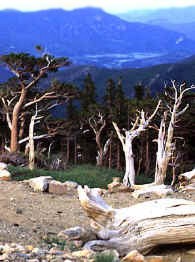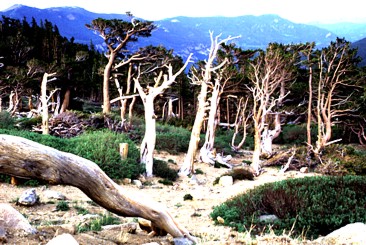Bristlecone Pine Forest - The Oldest Living Trees on Earth:

A mysterious and rather exotic pine forest has stood silent watch at the timberline of Mt. Goliath, in the North American Rocky Mountains for several centuries. Isolated and peaceful, the only sounds you will here at this elevation are the occasional screech of an eagle, and the whispering of the chilled mountain breeze as it weaves its way thorough the rocks and the branches of this unusual forest.
What is so remarkable about an old pine forest you ask? Well first, this forest has been a special and sacred place for Native Americans since the dawn of man's history in North America. It is a place of spirits and powerful forces as evidenced by the bizarre, contorted and twisted shapes of the gnarled trees.
This is a forest of the power of life. While many of the strange trees appear to be dead and stripped of their life sustaining bark, they are in fact alive. What makes this forest even more remarkable, is that these specific trees have witnessed the passage of centuries. The Bristlecone Pine is the oldest living organism on earth.
These trees are known to live to be any where from 1,500 years old to more than 4,000 years old. In fact, the oldest known Bristlecone, found in Nevada, was 4,964 years old. To put this into perspective, realize that some of these trees were standing when the Great Pyramids of Egypt were being built, and that they are still living today.
As you explore the Bristlecone forest, if you move very quietly, and pay very close attention to your thoughts, you can almost make out the distant voices of time.

The grotesque appearance of the trees is a statement to the determination of life; several show only the faintest signs of life, supporting only a few, or sometimes just one living branch.
These sparse, living branches are all connected to the tree's root system by a very narrow layer of nurturing bark.
In such a hostile environment of long months and years turning to centuries of ice, snow, and high winds, the bark of these magnificent trees has been scoured and blasted away, leaving the trunks bare, and polished to a smooth silvery gray. And still, they survive.
The range of the Bristlecone extends from just south of Rocky Mountain National Park, down through central Colorado, and deep into the Sangre De Cristo mountain range in New Mexico.
Photos and articles by: Dr. Von Zuko © MMXVI
